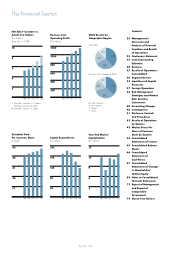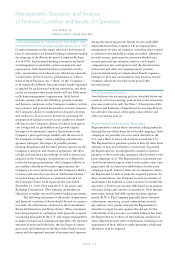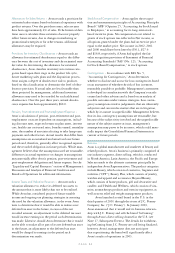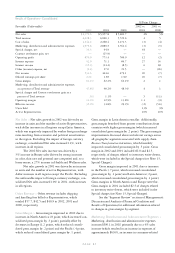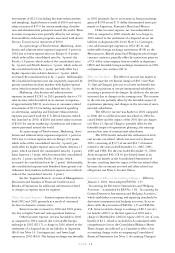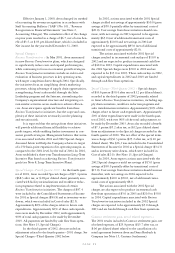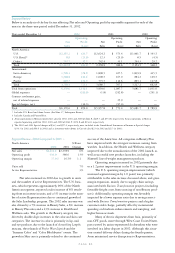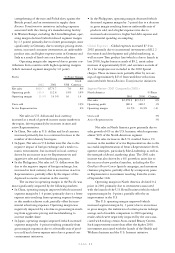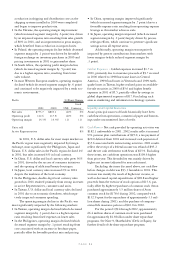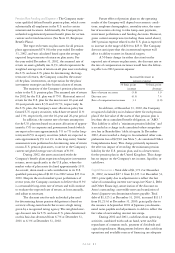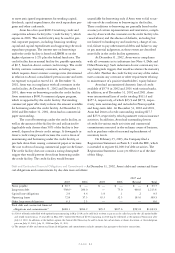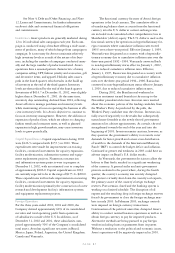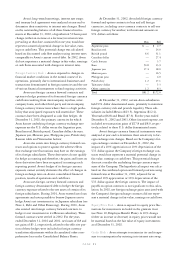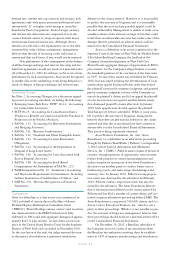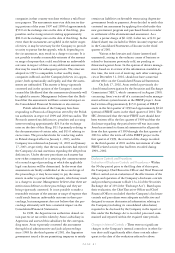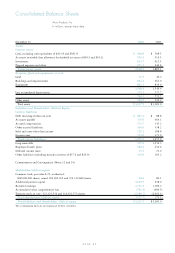Avon 2001 Annual Report Download - page 11
Download and view the complete annual report
Please find page 11 of the 2001 Avon annual report below. You can navigate through the pages in the report by either clicking on the pages listed below, or by using the keyword search tool below to find specific information within the annual report.
PAGE 35
Pension Plan Funding and Expense > The Company main-
tains qualified defined benefit pension plans, which cover
substantially all employees in the U.S. and in certain
international locations. Additionally, the Company has
unfunded supplemental pension benefit plans for certain
current and retired executives. (See Note 10, Employee
Benefit Plans).
The expected return on plan assets for all pension
plans approximated $74.0 for the year ended December
31, 2002, and was calculated based upon the average
expected long-term rate of return on plan assets. For
the year ended December 31, 2002, the assumed rate of
return on assets globally was 8.3%, which represents the
weighted average rate of return on all plan assets including
the U.S. and non-U.S. plans. In determining the long-
term rate of return, the Company considers the nature
of the plans’ investments, an expectation for the plans’
investment strategies and the historical rates of return.
The majority of the Company’s pension plan assets
relate to the U.S. pension plan. The assumed rate of return
for 2002 for the U.S. plan was 8.75%. Historical rates of
return for the U.S. plan for the most recent 10-year and
20-year periods were 8.3% and 10.7%, respectively. In
the U.S. plan, the Company’s asset allocation policy has
favored U.S. equity securities, which have returned 11%
and 13%, respectively, over the 10-year and 20-year period.
In addition, the current rate of return assumption
for the U.S. plan was based on an asset allocation of approx-
imately 35% in corporate and government bonds (which
are expected to earn approximately 5% to 7% in the long-
term) and 65% in equity securities (which are expected to
earn approximately 9% to 11% in the long-term). Similar
assessments were performed in determining rates of return
on non-U.S. pension plan assets, to arrive at the Company’s
current weighted average rate of return of 8.3%.
During 2002, the assets associated with the
Company’s benefit plans experienced negative investment
returns, most significantly in the U.S. plan, where the
market value of plan assets declined approximately 13%.
As a result, Avon made a cash contribution to its U.S.
qualified pension plan of $120.0 in 2002 versus $25.0 in
2001. Despite the stock market’s poor performance of
recent years, the Company continues to believe that 8.3%
is a reasonable long-term rate of return and will continue
to evaluate the expected rate of return, at least annually,
and adjust as necessary.
The discount rate for each individual plan used
for determining future pension obligations is based on
a review of long-term bonds that receive a high rating
given by a recognized rating agency. The weighted-aver-
age discount rate for U.S. and non-U.S. plans determined
on this basis has decreased from 6.7% at December 31,
2001 to 6.3% at December 31, 2002.
Future effects of pension plans on the operating
results of the Company will depend on economic condi-
tions, employee demographics, mortality rates, the num-
ber of associates electing to take lump-sum payments,
investment performance and funding decisions. However,
given current assumptions (including those noted above),
2003 pension expense related to the U.S. plan is expected
to increase in the range of $20.0 to $25.0. The Company
does not anticipate that this incremental expense will
affect its ability to meet its financial targets.
A 50 basis change (in either direction) on the
expected rate of return on plan assets, the discount rate or
the rate of compensation increases would have the follow-
ing effect on 2002 pension expense:
Increase/(Decrease) in
pension expense
50 basis point 50 basis point
increase decrease
Rate of return on assets (3.9) 3.9
Discount rate (6.3) 7.4
Rate of compensation increase 3.1 (3.0)
In addition, at December 31, 2002, the Company
recognized a liability on its balance sheet for each pension
plan if the fair value of the assets of that pension plan is
less than the accumulated benefit obligation, or “ABO.”
This liability is called a “minimum pension liability” and
is recorded as a charge in Accumulated other comprehen-
sive loss in Shareholders’ (deficit) equity. In December
2002, Avon recorded a charge to Accumulated other com-
prehensive loss of $239.0 (see Note 5, Accumulated Other
Comprehensive Loss). This charge primarily represents
the after tax impact of recording the minimum pension
liability for the U.S. pension plan, and to a lesser extent,
for the pension plan in the United Kingdom. This charge
has no impact on the Company’s net income, liquidity, or
cash flows.
Capital Resources > Total debt of $1,372.2 at December
31, 2002, increased $47.1 from $1,325.1 at December 31,
2001, principally due to adjustments to reflect the fair
value of outstanding interest rate swaps (see Note 4, Debt
and Other Financing), amortization of the discount on
Avon’s outstanding convertible notes and translation of
Avon’s Japanese yen denominated notes payable. Total
debt of $1,325.1 at December 31, 2001, increased $111.5
from $1,213.6 at December 31, 2000, principally due to
the issuance in September 2001 of Japanese yen denomi-
nated notes payable and adjustments to debt to reflect the
fair value of outstanding interest rate swaps.
During 2002 and 2001, cash flows from operating
activities, combined with cash on hand, were used for
repurchases of common stock, payment of dividends and
capital expenditures. Management believes that cash from
operations and available sources of financing are adequate

